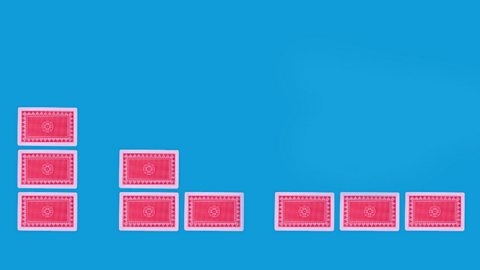Working with money
Wages and salaries
Wages and salaries are different ways of paying workers.
In general, wages refer to hourly pay and salaries refer to annual pay.
Wages are paid weekly based on the number of hours worked. To calculate wages, the hourly rate of pay for that job is multiplied by the number of hours worked that week. Workers are not usually paid for lunch or other breaks.
Salaries are based on an annual amount and are paid every month. The annual salary is divided by 12 to calculate monthly earnings.
Example
Aidan has a part-time job at a garden centre and earns £8.50 per hour. He works two days a week from 9 am to 5.30 pm with 1 hour 30 mins off for lunch and breaks.
What is Aidan’s wage for that week?
Solution
Each day, Aidan works from 9 to 5.30 which is 8.5 hours. We need to subtract the 1.5 hours for lunch and breaks.
8.5-1.5 = 7
Aidan gets paid for 7 hours work.
7 x £8.50 = £59.50
He works 2 days per week.
Total wage = £59.50 x 2 = £119
Answer
Aiden earned £119 that week
Example
Laura works as an electronic engineer and her salary is £45000. How much does she get paid per month?
Solution
£45000 is for 12 months
£45000 ÷12 = £3750
Answer
Laura gets paid £3750 per month.
Example
Rory works in a coffee shop every Friday and Saturday. He is paid £9.80 per hour and time and a half at weekends. One week he worked 5 hours on Friday and 6 hours on Saturday. How much did he earn that week?
Solution
On Friday, Rory earns £9.80 x 5 = £49
On Saturday, for every hour he works, he gets paid ¬£9.80 + ¬Ĺ of ¬£9.80.
¬£9.80 + ¬Ĺ of ¬£9.80 = ¬£14.70
£14.70 x 6 = £88.20
Rory earns £88.20 on Saturday.
Altogether Rory earns £49 + £88.20 = £137.20
Answer
£137.20
Question
Connor and Catherine are comparing how much they earned the previous month.
During that month, Catherine worked 8 hours every day for 22 days. She gets paid £15 per hour.
Connor gets paid a yearly salary of £32400
Who earned more money that month? How much more?
Catherine: 15 x 8 x 22 = £2640
Connor: 32400 ÷ 12 = £2700
2700-2640 = 60
Answer:
Connor earned £60 more.
Profit and loss
When a business buys something and then sells it on, they can:
- make a profit (make more money than they spent) or
- make a loss (make less money than they spent) or
- break even (make the same amount of money as they spent)
Example
Finn makes candles to sell at the local market. To make 50 candles, he spends £88 on the wax, £15 on the wicks and £11 on the electricity to make them. He also spends 35p on packaging for each candle. He sells the candles for £4.99 each.
Calculate his profit or loss on 50 candles.
Solution
Altogether, to make 50 candles Finn spends:
£88 + £15 + £11 = £114
He also spends 35p on packaging for each candle.35 x 50 = 1750 (Remember that this is 1750 pence, and the other amounts are in £s.)
1750p = £17.50
114 + 17.50 = £131.50
Finn spends £131.50 altogether.
He sells 50 candles at £4.99 each
50 x £4.99 = £249.50
He makes a profit because he makes more money than he spends.
£249.50 - £131.50 = £118
Answer:
Finn makes £118 profit.
Question
Aoife sells tie dye tee shirts from home. She buys 60 white tee shirts online for £3.50 each and spends £45 on dye. Other expenses such as electricity and postage come to £28.
Aoife wants to make a profit of at least £100. What is the lowest price that she can charge for each tee shirt?
Solution:
Aoife spends
60 x £3.50 + £45 + £28 = £283
She wants to make £100 profit, so she needs to sell the tee shirts for at least £283 + £100 = £383.
She has 60 tee shirts to sell.383 ÷ 60 = 6.3833333…
Normally we would round down but in order to make at least £100 Aoife needs to round up= £6.39 rounded up to the nearest penny.
Answer:
Aoife needs to sell her tee shirts for at least £6.39 each.
Simple interest
When you deposita sum of money paid into a bank or building society account. money in a bank, it will pay you interest An amount of money a lender or bank receives for lending out money or an individual receives for saving money for allowing them to use your money.
When you borrow money from a bank, you will have to pay interest to the bank.
The amount of interest depends on the interest rateThe cost of borrowing as an annual percentage of the loan. When you save it is the rate your are paid by the bank..
Interest rate is a percentage that changes depending on the economic conditions in the country at the time.
Simple interest interest that is earned or paid on the original amount of money (the principal). The amount earned or paid is the same every year.Simple interest can be calculated using the formula:
\(\color{purple} \Large {\text{simple interest}} = \frac{{P}\times{T}\times{R}}{100}\)
Where:
P = the principal (the original amount of money)
T = the time in years that the interest is to be calculated
R = the interest rate which is given as a percentage
Example
Jack borrows £4500 from his bank. He has arranged to pay it back over 3 years at an interest rate of 6.5%. How much interest does he have to pay on this loan?
Solution:
Use the formula:\(\color{purple} {\text{simple interest}} = \frac{{P}\times{T}\times{R}}{100}\)
- P = £4500
- T = 3
- R = 6.5
\(\color{purple} {\text{simple interest}} = \frac{{4500}\times{3}\times{6.5}}{100} = £877.50\)
Answer:
Jack pays £877.50 interest on the loan.
Bank accounts
Banks provide different types of accounts depending on the needs of the customer. Most people have an account where they deposit their wages or salary and then use it to pay their bills and for day-to-day expenses.
Every month, the bank sends out a statement to each customer showing how much they have deposited (credit) and how much they have spent (debit). It may also give details of what the customer has spent their money on. The statement shows the balance for the account ‚Äď the total amount of money in the account at that time.
A typical bank statement
Example
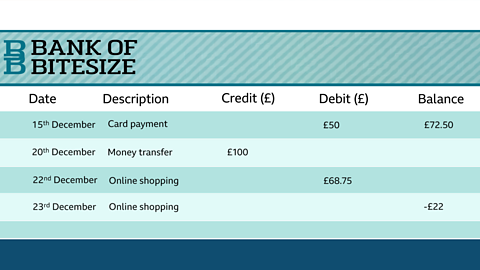
Image caption, This table is part of Charlotte’s bank statement for December.
Complete each line of the table - The first line is already complete. Remember that in each row, only the debit or credit column will have a figure in it.
Image caption, Line 2 ‚Äď Someone has transferred ¬£100 to Charlotte‚Äôs account so the balance will be ¬£72.50 + ¬£100 = ¬£1752.50
Image caption, Line 3 ‚Äď Charlotte spends ¬£68.75 so her balance will be ¬£172.50 ‚Äď ¬£68.75 = ¬£103.75
Image caption, Line 4 ‚Äď Charlotte‚Äôs balance is negative. This means that she has spent ¬£22 more than her balance. ¬£103.75 + ¬£22 = ¬£125.75
1 of 4
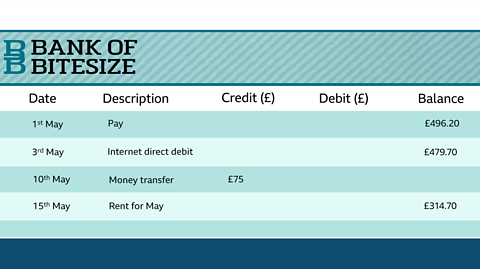
- Complete the statement for 3rd May and 10th May.
- How much is Michael charged for rent each month?
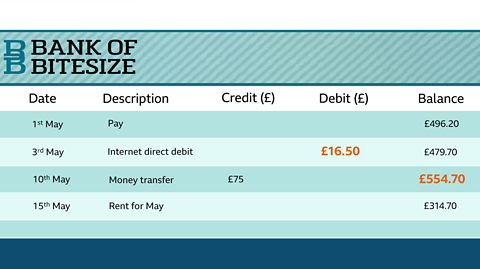
Solution
3rd May: 496.20 ‚Äď 479.70 = 16.50
£16.50 was debited for Michael’s internet
10th May: 479.70 + 75 = £554.70
Michael’s balance was £544.70 on 10th May£554.70 - £314.70 = £240
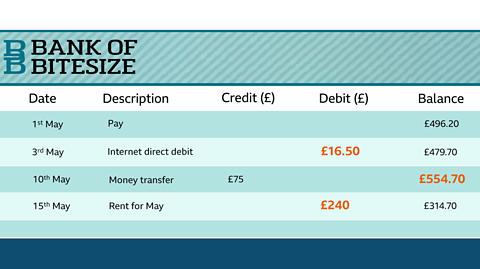
Answer:
Michael paid £240 for his rent.
Test yourself
More on M1: Number
Find out more by working through a topic
- count1 of 7
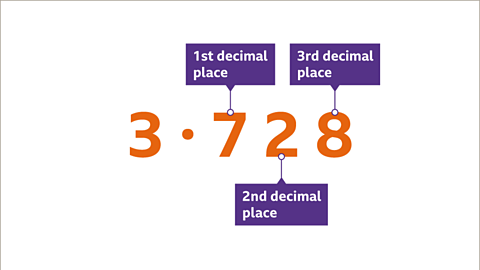
- count2 of 7

- count3 of 7

- count4 of 7
